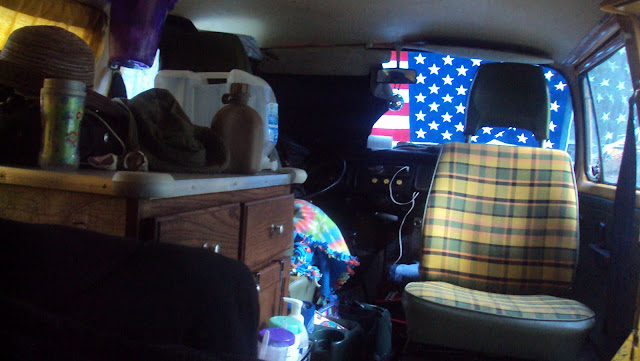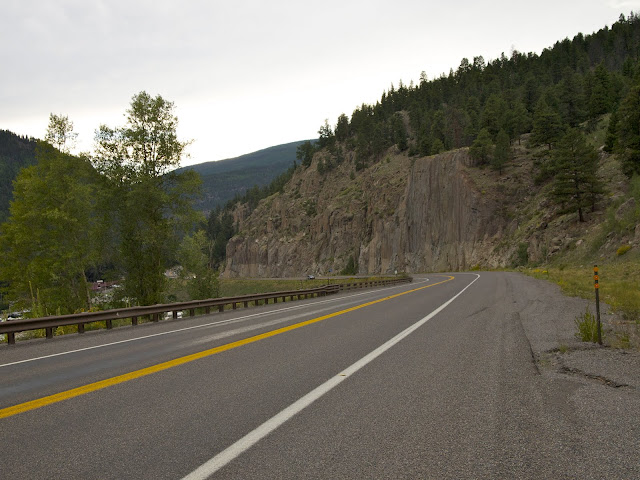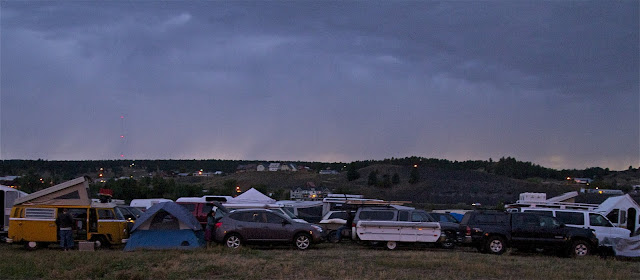Exploring these highways and byways is my favorite way to pass a day away. My neck gets to hurting, and I have some kind of mental tic that makes me hold on to the steering wheel with a full on death grip. Although the chance to soak in views like these, makes me forget my aches and pains in no time.
 |
The Pig sporting a wind blown wagon.
Every time I take the Pig on these roads, I feel a little more attached to it. It's growing quite the resume of Colorado travel destinations. I find myself wrestling with the notion of staying out on the road. I get behind that wheel and I just want to keep driving. There is so much to see, and just not enough time to get it all in. Highway 160 was worth the few extra miles, and I will never forget what it was like to travel along this great road.
Just before arriving in Pagosa Springs, you have to conquer Wolf Creek Pass. It's a long steep grade, but has a very VW Bus friendly two lanes in each direction. Slow moving vehicles get a reprieve here, and it is necessary. 3rd gear wasn't doing it on this pass. I had to put it is 2nd and just ride like that for the entire time.
Slow driving on this pass isn't really a bad thing. There is plenty to look at to keep your mind off of the slow pace. C.W. McCall wrote a song about the pass, a lyric describes it as "37 miles of Hell, which is up on the Great Divide".
|
 |
The bottom of Wolf Creek Pass
The Four Corners Folk Festival camping line was waiting for us in the city. We pulled into our spot right behind a Nissan Rouge. We met our first VW of the festival here, a Eurovan dubbed Evie The Barbie Bus. I'll show you a picture of her later in my installment of VWs of Four Corners Folk Fest.
|
With Wolf Creek Pass under our belt, we had arrived.
Pagosa Springs is a small town about 35 miles from the border of New Mexico. It's in the middle of the San Juan National Forest, sitting at about 7,000 feet. Wolf Creek Ski Area is nearby, and the town is named for its Hot Springs. The Ute Indians dubbed them "Pah gosah" which translates to "healing waters". You can smell the sulfur the second you hit town, and it struck me as unpleasant at first. The population is only about 2,000, but the area is a hot bed for tourists. There is something for all seasons, skiing and snowmobiling in the winter months, camping, fishing, hiking and rafting in the summer, and Elk and Deer hunting in the fall. I found the hot springs to be very inviting on a cool summer morning. I was able to slide on my flip-flops, hop out of the bus, and head into town to find the first manhole that had that hot stream rising from it. These springs are great for warming your feet.
 |
| Pagosa Springs |
 |
| The San Juan River |
 |
Our Campsite on Workshop Row
The Festival started on Friday, and we were in line by early Wednesday evening. They let the campers head up Reservoir Hill on Thursday afternoon. I thought everything was running rather smoothly until it was time to head up the hill. Once you are in the actual campground, that's when the madness ensues. There really aren't any marked camping spots. It's pretty much a free-for-all. After about 5 tries, we found a level spot to camp on and set up shop. Reservoir Hill is just that, a hill. If you ever plan on attending this festival or camping here, bring some chalks or else you will be having that "I should of had a V8" effect whenever you sleep.
 You have your choice of camping midway up the hill, right by the entrance to the stage, or further up the hill past the stage. We made an attempt at the Main Campground, but it was just a little too crazy for our taste. I noticed camps that named themselves things like Camp Cumonawanalaya, or Camp Run Amok. I'm more of a mellower partier these days, so we elected to stray a little further away and camp in an area called Workshop Row.
|
 |
Workshop Stage
Our campsite was just a hop, skip, and jump away from the Workshop Stage. Several of the musicians came over here and held question and answer sessions as well as play intimate sets for smaller crowds. A nice touch to an already awesome event.
|
 |
The Pig's Aura
Fires are only allowed in metal containers. So we set ours up in close proximity to the bus. Our spot was situated on a slightly elevated area just above the workshop stage. We ended up buying a steel tub from a hardware store and drilling holes in it. Next year we will have already acquired a washing machine tub. They seem slightly more compact to transport.
 |
Roast Pig
Our neighbor just below us, known to me only as "The Tarp Master" hosted an outstanding picking circle on Friday night after the final act. I heard Banjos, Mandolins, a Fiddle, a Flute, some Tambourines, and someone was even playing the spoons. This circle made the whole trip worth while for me. Thank you Tarp Master.
|

The Tarp Masters Camp
|
 |
The Tarp Master puts on a show
|
 |
Inside the Pig
All in all, it was a great trip. The Festival was a blast, and had a lot to offer. Our inexperience presented us with a few challenges that we had to overcome, but for four days we were part of a community of like minded, music loving people. We danced with our daughter in a field at 7,000 feet, surrounded by blue skies, mountain vistas, and beautiful bluegrass music. We lay in our bus at night, falling asleep to the sounds of fellow campers singing and playing instruments all night long.
|
 |
Black and White
|
 |
The Pig's Family
Sufficiently worn out from our great time, it was time to head on back to Denver. The ride home is just as wonderful as the ride up.
|
 |
| A lot worker we met came by and talked to us about the Pig. He was a die hard VW guy, even showed us a VW logo tattooed to his forearm. I regret not asking him if I could snap a photo of it. I'm still getting used to being more social. Baby steps. |
 |
| Highway 160 heading east on our way home. |
 |
| Terrain along Highway 160 |
 |
| A quick break on the way home |
 |
Resting in Pueblo
Stay tuned for the next post: VWs of Four Corners Folk Festival
Thanks for reading!
|
















